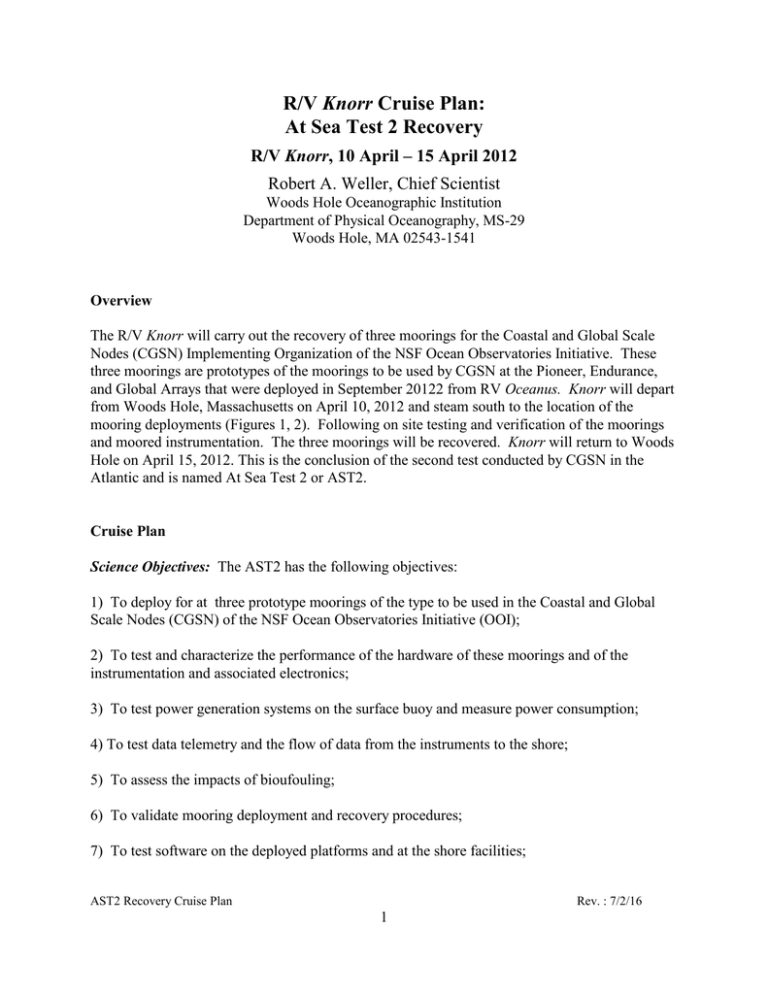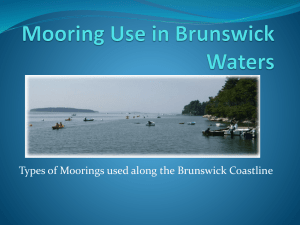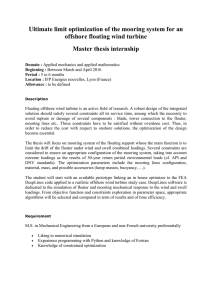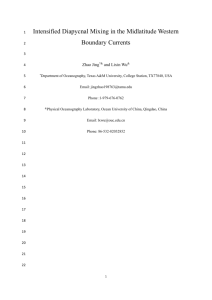AST2_cruise_plan_recovery.doc
advertisement

R/V Knorr Cruise Plan: At Sea Test 2 Recovery R/V Knorr, 10 April – 15 April 2012 Robert A. Weller, Chief Scientist Woods Hole Oceanographic Institution Department of Physical Oceanography, MS-29 Woods Hole, MA 02543-1541 Overview The R/V Knorr will carry out the recovery of three moorings for the Coastal and Global Scale Nodes (CGSN) Implementing Organization of the NSF Ocean Observatories Initiative. These three moorings are prototypes of the moorings to be used by CGSN at the Pioneer, Endurance, and Global Arrays that were deployed in September 20122 from RV Oceanus. Knorr will depart from Woods Hole, Massachusetts on April 10, 2012 and steam south to the location of the mooring deployments (Figures 1, 2). Following on site testing and verification of the moorings and moored instrumentation. The three moorings will be recovered. Knorr will return to Woods Hole on April 15, 2012. This is the conclusion of the second test conducted by CGSN in the Atlantic and is named At Sea Test 2 or AST2. Cruise Plan Science Objectives: The AST2 has the following objectives: 1) To deploy for at three prototype moorings of the type to be used in the Coastal and Global Scale Nodes (CGSN) of the NSF Ocean Observatories Initiative (OOI); 2) To test and characterize the performance of the hardware of these moorings and of the instrumentation and associated electronics; 3) To test power generation systems on the surface buoy and measure power consumption; 4) To test data telemetry and the flow of data from the instruments to the shore; 5) To assess the impacts of bioufouling; 6) To validate mooring deployment and recovery procedures; 7) To test software on the deployed platforms and at the shore facilities; AST2 Recovery Cruise Plan Rev. : 7/2/16 1 8) To validate mooring designs. Plan to Meet the Objectives: Three prototypical moorings, a coastal surface mooring, a costal profiling mooring, and a hybrid profiling mooring have been designed and built. Integration, onshore test, burn-in was conducted in July to September, 2011. A Test Readiness Review was conducted at WHOI on September 9, 2011. Deployment occurred on the cruise on R/V Oceanus in September, 2011. Recovery is planned for April 2012 using R/V Knorr. Data from the moorings during the deployment will be monitored at WHOI and at SIO. Data recovered from telemetry and internal data storage will be analyzed subsequent to the April recovery as part of the assessment of success at meeting the objectives. Staging/Destaging: Preparation for the recovery cruise will take place at the Woods Hole Oceanographic Institution (WHOI) starting in April 2011. On or before April 8, 2012 the moorings, instruments, winches, and other deck and lab gear will be staged at the WHOI dock for loading beginning April 9, 2012. A TSE mooring winch and a new Heavy Lift Winch will be put on board. Offloading of all gear, from the lab and from the deck, will take place after arrival back at Woods Hole on April 15 and be complete on September 16, 2012. Recovered gear will be transported to Coastal Research Laboratory on Quisset Campus for downcruising and, for the SIO and BIO gear, packing for shipment home. Operations: The cruise involves the principal operations, as listed below. These operations are expected to be accomplished within the allocated 5 ship days. A proposed timeline is provided in Table 1. This timeline will be revised as conditions warrant. 1. During the transit to the moorings sites and whenever possible while working in the region, Knorr will use the mutlibeam to obtain further bathymetry of the Pioneer Array area. As cruise permits, fill in more bathymetry for AST2 mooring siting. 2. The Coastal Pioneer Surface Mooring (CPSM) and Coastal Pioneer Profiling Mooring (CPPM) were deployed next to each other, separation of about 500m close to 39° 55.0’N, 70° 47.5’W, in 520 m of water. This site and the bottom bathymetry are shown in Figure 3. Both will be recovered. 3. Recovery of the CPSM (Figure 4) includes recovery of the benthic anchor and recovery frame (BARF) (Figure 5). The CPSM tower was lost and the well will carry water. Initial documentation of the condition of the CPSM. 4. Recovery of the CPPM (Figure 6) following final on site test and verification. 5. The SIO/BIO Global Hybrid Profiler hybrid profiling mooring site was 25 nm further south in roughly 2,500 m of water (Figure 7). The mooring was deployed close to 39° 30.0’N, 70° 47.5’W, in 2,480 m of water. This site and the bottom bathymetry are shown in Figure 3. 6. Test and verification work on the hybrid profiling mooring. AST2 Recovery Cruise Plan Rev. : 7/2/16 2 7. Recovery of the hybrid profiling mooring (Figure 8). Cruise chronology: April 9-10, 2012 Load RV Knorr with recovery gear. April 10, 2012 12:00 local ~22:00 local Depart Woods Hole, underway to 39° 55.0’N, 70° 47.5’W site for coastal moorings; 110 nm to steam at 10 kts Arrive mooring site for CSP, CPM; test acoustic releases April 11-14, 2012 Mooring recoveries, weather permitting Mulitbeam surveying at night April 15, 2012 Return to WHOI, unload April 16, 2012 Finish unload, movement of gear to CRL Shipboard Services: A variety of shipboard services will be required during the cruise in addition to support for mooring operations. The principal items are described below. CTD Operations: Profiles next to CPPM and GHP. Networking: Standard ship to shore transfer of data and email. Navigation: GPS to be logged, deployment tracks for mooring deployments to be provided. Bathymetry: A display of, or access to, real-time bottom depth information will be required during mooring deployment operations. Multibeam to be run whenever possible and to fil Meteorological and oceanographic data: The Underway Data System (IMET and TSG) and both ADCPs should be operated continuously during the cruise. Real-time access to the navigation, bathymetry, meteorology and TSG data (but not the ADCPs) will be particularly important during the test and verification periods. Small boat operations: The small boat will be onboard in case of need to go to the CSM or GHP, given approval by the Captain. AST2 Recovery Cruise Plan Rev. : 7/2/16 3 Figure 1. Overview of cruise area, with coastal mooring site and global mooring site. AST2 Recovery Cruise Plan Rev. : 7/2/16 4 Figure 2. The AST2 cruise overview. Woods Hole is the port for the start and the finish. The two coastal moorings are deployed close to 39° 55.0’N, 70° 47.5’W in ~520 m of water; the Global Hybrid Profiler (GHP) is deployed close to 39° 30.0’N, 70° 47.5’W in ~2,480 m of water AST2 Recovery Cruise Plan . Rev. : 7/2/16 5 Figure 3 Bathymetry at coastal mooring site. The black line is the cruise track. The coastal mooring site is labeled and highlighted in yellow. AST2 Recovery Cruise Plan Rev. : 7/2/16 6 Figure 4 Diagram of the coastal surface mooring with BARF. AST2 Recovery Cruise Plan Rev. : 7/2/16 7 Figure 5 Drawing of the BARF. AST2 Recovery Cruise Plan Rev. : 7/2/16 8 Figure 6 Diagram of the coastal profiling mooring. AST2 Recovery Cruise Plan Rev. : 7/2/16 9 Figure 7. Bathymetry at hybrid profiling mooring site. AST2 Recovery Cruise Plan Rev. : 7/2/16 10 Figure 8. Hybrid profiling mooring diagram AST2 Recovery Cruise Plan Rev. : 7/2/16 11 Personnel Chief Scientist, contact information Dr. Robert A. Weller 204A Clark Lab, MS-29 Woods Hole Oceanographic Institution (WHOI) Woods Hole, MA 02543-1541 508-289-2508 (voice), 508-457-2181 (fax) rweller@whoi.edu Science Party being developed 1. Name Robert Weller Affiliation WHOI Gender m Email rweller@whoi.edu, Ch. Scientist 2. John Kemp WHOI m jkemp@whoi.edu, Exp leader AST2 Recovery Cruise Plan Rev. : 7/2/16 12



